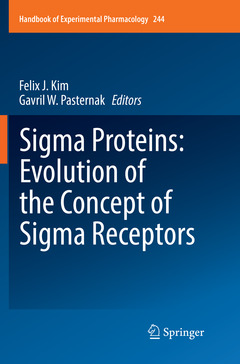Sigma Proteins: Evolution of the Concept of Sigma Receptors, Softcover reprint of the original 1st ed. 2017 Handbook of Experimental Pharmacology Series, Vol. 244
Coordonnateurs : Kim Felix J., Pasternak Gavril W.

Preface.- Historical perspective and background - including Sigma protein subtypes and ligand selectivity.- Sigma imaging agents.- Medicinal chemistry.- 3-dimensional homology models of Sigma1.- Neuronal plasticity and ion channels.- Opioid receptors and other GPCR.- Cancer.- Neurodegenerative diseases.- Pain.- Cognition, learning, neurological disorders.- Drug abuse and addiction.- Alcohol Abuse.- Stroke and neuroprotection.
Provides an updated perspective on this rapidly evolving field undergoing changes in fundamental concepts of key importance to the discipline of pharmacology
Emphasis is laid on the roles of sigma proteins in pathophysiology and on emergent therapeutic initiatives
New investigators combined with more experienced investigators - as represented by the editors
Date de parution : 08-2018
Ouvrage de 330 p.
15.5x23.5 cm
Date de parution : 10-2017
Ouvrage de 330 p.
15.5x23.5 cm
Thèmes de Sigma Proteins: Evolution of the Concept of Sigma Receptors :
Mots-clés :
Chaperone; Neurodegenerative disease; Pain; Pathophysiology; Protein homeostasis; Scaffold



